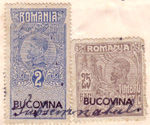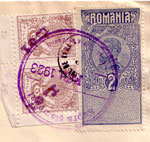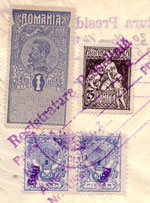| |
 |
Kingdom of Romania, overprints and over-stamped in the new territories 1918-1920 |
 |
|
 |

Photo 1
|
After the First World War and the Versailles and Trianon treaties, the Kingdom of Romania incorporates provinces belonging to the former Austro-Hungarian Empire (Transilvania, Banat, Bucovina) and the Russian Empire (Basarabia). These territorial modifications impose a series of legal, political and economical efforts, for the unification, consolidation and modernization of the new state structures. In the fiscal field, the introduction of new laws and their adaptation was done with difficulties, often the old structures delaying their implementation.
As such, on documents used in these territories you will find both the stamps of the administration as well as those of the new administration, applied to complete the fiscal tax (photo 3 and photo 4). Also we find stamps of the old administration overprinted with the value of the new currency (photos 5, 6, 7 and 8), or overprinted locally on the basis of an ordinance, in the spirit of the law. In the present article I present only the general phenomenon, and I will detail it only where sufficient study material is available, opening the way to future, more elaborate and exact studies with the support of philatelists and researchers of the laws which governed those changes.

Photo 6
|
Overprints and pre-cancellations
The practice of overprinting dates from the appearance of the stamp, in the case of revenues being
commonly used. The monetary rate change, the change of the ruler or the state, the change in destination of a tax are some of the situations for the overprint, in the majority of cases national issues being used.
Besides these situations we find local or administrative issues which functioned until that date, reused by overprinting with the data of the new administration circulating besides the national issues until their complete replacement.
The factors which generated this are varied, from the delayed supply with the new issues, the intention to avoid the law or the redirecting of taxes, to misunderstanding of the new regulations. The way overprints of national issues were done is relatively unknown, in the philatelic circuit entire overprinted sheets not being known, leading to interpretations without a solid base. All that is known is the fact that national issues were overprinted by the Stamp Works through typographical procedures, with printing ink, according to Decree 1176/12.03.1919*, the way it was laid on the sheet unknown.
The varieties observed to date, appear from overprinting through typographical procedures, by the manual gathering of separate letters and graphic elements. Local overprints, besides those done by the Ministry of Finance for national and local issues, were done by stamping, according to regulations included in the Official Bulletin, or local ordinances. The stamps used were usually locally manufactured, from gum and using stamp ink, hence the large variety of colours and nuances. Because they were applied manually, inclinations, doubles, reverses or spectacular displacements were frequent. It is hard to justify this phenomenon, due to lack of concrete legal information, local archives being hard to reach, or inexistent for that period. I try to inform the readers using material from my personal archive, enthusiasts of elaborate studies being free to help complete the information.
I consider it necessary that these local overprints are well studied and interpreted, using archive material with great attention because the situation often arises when original or unknown pieces are considered fakes, or the other way round. I already started the series about Romanian overprints, all based on personal observation, remaining that, as the documents available permit me, I will continue to present new varieties and discoveries.
The BUCOVINA overprint on Carol I 1911 and Ferdinand 1919 national revenue stamps
In 1919, at the Stamp Works were printed revenue stamps for Bucovina, of 10 and 30 bani, typographically, with the cliché of the Carol I 1911 issue, overprinted with "M.F." and "BUCOVINA".

Photo 3
|
In 1919 the revenue stamps with the effigy of King Ferdinand are issued, with the following values: 10, 30 and 50 bani, 1, 2, 3, 4, 5, 10, 20, 30, 40 and 50 lei. The 20 and 50 lei issues, being forged, were quickly withdrawn from circulation. ** Specialized Catalogues*,*** mention that all the values of these issues were overprinted, but personally I only found it on the 10 and 30 bani, 1 and 5 lei on the Carol I issue and on the 50 bani and 1 and 2 lei on the Ferdinand issue. I make a necessary comment here. Information presented in existing catalogues not always present the reality and I do not believe they should be considered as Law, many compiling older information presumed to be verified. For now I have some reservations towards the classifications Type Forbin, made 85 - 90 years ago. I consider that a better communication and more implication in researching these issues can lead to a future, more complete, work on the subject.
In the newspaper the "Glasul Bucovinei" (Bucovina voice), Cernauti, no. 77/8/21.02.1919 the following announcement was inserted:
"Starting with the 20th of February 1919 will be sold, besides Austrian stamps, Romanian stamps, respectively, for now, of 10 and 30 bani and 1 and 5 lei. These stamps are ordered equal in value with the 10 and 30 heller and 1 and 5 corona. They will bear the BUCOVINA overprint" ****
The statute for the introduction and use of these revenue stamps are not completely cleared, in circulation being found both national as well as overprinted revenue stamps. Probably, due to the provisory statute of autonomy of the province, the misappropriation of funds resulting from the sale of these stamps to the local budget was attempted. Starting with the autumn of 1920, the Government of Romania assumes the direct government of the new provinces, as such the overprinted stamps becoming obsolete, and are gradually replaced with national issues.
For the BUCOVINA overprint we can observe the four types executed at the Stamp Works, already consecrated in existing catalogues (type I, II, III and IV), but I bring to
your attention and propose a new type, type V (photo 9), and two varieties of type I (photo 1), leaving future research to confirm or not, their introduction as new types. The overprint is frequent on the Ferdinand national issue printed on war paper but is sometimes found on the new issue, on chalked paper. I present and explain here the types already known. Besides the personal discoveries, on the studied material:

Photo 4
|
- Type I, body with large letter, marked with curbed lines, more pronounced on the letters V and A;
- Type II, the entire letter body smaller and the marking accentuated serif;
- Type III, large letters, accentuated serif as in type II;
- Type IV, large letter body, sans-serif the size of type I and III.
For the cases discovered and named by me:
- for type Ia the letter "N" is substituted with the letter "n", font size the same with the other letters;
- for type Ib the letter "B" is vertically elongated and horizontally compressed, having the form of an ancient ark;
- type V with letters type Arial Rounded MT bold, the overprint being applied locally by stamping, the used ink leaving absorption marks on the paper, similar to bloating paper (photo 9).

Photo 9
|
I have not yet found the type V on chalked paper stamps, so that I might compare the ink absorption, process which varies according to the ink and the paper it is applied on. Most issues of Ferdinand revenues are printed on war paper of inferior quality, which acts as bloating paper in the case of stamp inks. It is interesting that most documents studied to date, present the general particularity regardless of the place of issue, of being completed before the tax stamp is applied, the tax being applied and canceled after they are collected in a larger center. Probably this was the procedure over the entire territory of the Grand Romania, the documents discovered so far confirming this.
The stamp and registration Law provisioned that for all documents subject to taxation stamped papers should be used (special sheets issued buy the Ministry of Finance on watermarked papers and

Photo 2
|
fixed stamp in the upper left corner), and in its absence corresponding revenue stamps to be applied, on the especially provisioned corner, as a rule the upper left side, and in the situation in which stamps are not available, to leave a place for their later application. I also observed that some companies or organizations (parishes, courts, and notaries) used in stead of the stamped paper sheets of paper with stamps already applied on the special place, after payment of tax being completed. This is why revenue stamps are found with text over them, instead of the cancellation by stamp and signature, the text itself canceling them. For this reason we find over stamped and overprinted on documents already completed. The study of existing archives can help understand the use of this overprint.
In (photo 2) I present a curiosity, a pair of Ferdinand 1919 national issue of revenues which presents two types of overprints, III and IV, unique to the present date, pair which confirms the hunch of some researchers, that, at the Stamp Works, immediately after the war there were not enough letters to form the BUCOVINA word, identically 50 times *****
In (photos 3 and 4) I present fragments from two parish documents issued in May 1919, for which the
2 lei tax is collected by the mixed use of Austrian revenue stamps and the new Romanian revenue
stamps, even after the time interval granted by the Law for the withdrawal from circulation.
Because the space is not sufficient to detail this article in FILATELIA revue, for now I resume to my personal observation performed on a number of almost 200 documents and overprinted stamps, preparing a more detailed study as more information appears from you.
The overprint and over-stamped of local Hungarian issues, Cluj, Transilvania (1919 - 1920)

Photo 5
|
On the 24th of December 1918, King Ferdinand of Romania issued the Decree for the Unification of Transilvania with Old Romania. The public services were left in charge of the Ruling Council, and foreign affairs, the army, financial circulation, customs, public lending and state security came under central government in Bucharest. Transilvania was to be presented in the central government by ministers without portfolio, for each field in which the local government was losing control in favor of the central government. The Ruling Council proceeded, on the 25th of December 1919to the
administrative re-organization of the territories united with Romania, creating 23 districts.

Photo 8
|
The Ruling Council named prefects in all the 23 districts, as well as three prefects for the City Halls of Arad, Cluj and Sibiu. Regardless of the desire of Romanian leaders from Transilvania to maintain some autonomy within the Kingdom of Romania, the Ruling Council was dissolved by the authorities from Bucharest on the 4th of April 1920. This was due to the fact that the Paris Peace
Conference made the unification of Transilvania to the Romanian Kingdom irreversible, therefore, the Bucharest authorities not being obliged to make any concessions to the Transilvanian Romanians.
Returning to the tax collecting modalities, we can observe that in the firsts moths after the Union, Romanian stamps were absent in most cases. The Official Bulletin mentions the Revenues series Ferdinand 1919 as being issued for the special needs of Transilvania and Bucovina, but a large scale use of Romanian stamps is not present until 1920. In the intermediary period, tax
was mostly paid in cash, initially in filler then in lei.

Photo 7
|
Various documents are known, Court decisions, tickets with revenue stamps (similar to Hungarian tickets), Agriculture and Trade headers, even passports issued by the Ruling Council Internal Affairs, printed by the Iosif Drotleff print in Sibiu.
In other towns, as Bistrita, Cluj and Sighisoara, Hungarian revenue stamps were overprinted by the new authorities. In fact, the practice of over-stamping was widespread in Transilvania, in the first years after the Union, including on general use revenue stamps. In other cases, the cliché used for the overprinting of Romanian revenue stamps include parts of the local Hungarian issues (of course, with the replacement of the inscription in Romanian and the currency in lei). It is
the case of cities as Arad, Bistrita and Satu Mare. *****
To come to the support of the things mentioned above I present some typical situations for the
period, 1920 - 1923, with the use of local Hungarian revenue stamps, from Cluj, over-stamped or overprinted, next to Romanian national stamps, without entering into detailed explanations, the material and information existing, being insufficiently studied.
In (photos 5, 6 and 8) I present some overprinting and over stamping types. You can observe that the Hungarian revenue stamps already present a circular stamp in Romanian, OFICIUL DE VAMA SI CONSUM - CLUJ (Cluj Customs and consumer office), applied probably on all sheets of stamps in stock. After their aplication on the document, completing the revenue tax, another stamp and overprint was applied. The overprint replaced the value of the currency on the stamp with the value of the new currency (lei or bani) and the stamp (SUPRASTAMPILAT - PERCEPTORIA ORASULUI CLUJ, month and year) confirming it.
In (photo 7) apears a pair of Hungarian stamps, also over-stamped and overprinted with the new nominal value. The cancelation is done by the person issuing the document.
In closing this article I wish to appeal to readers who can help me complete the information already existing, to contact me on the e-mail address: federatia_filatelica@yahoo.com or my personal address franambrus@yahoo.com
Bibliography:
* Mihai Cojocar, "Catalogul timbrelor fiscale româneşti-2006";
** Monografia "Monitorul Oficial, 100 de ani, 1832-1932";
*** John Brefoot & Valentin Robu "Bulgaria & Romania revenues" 2003;
**** Calin Marinescu, articolul "Alte emisiuni poştale şi fiscale 1908-1918" Filatelia nr.6/2007;
***** Valentin Robu, article in Exhibition Catalogue "Revenue Stamp - 150 years from his appearance" 2006
Francisc Ambruş, FILATELIA revue Nr.10/2008
|
 |
|
|

